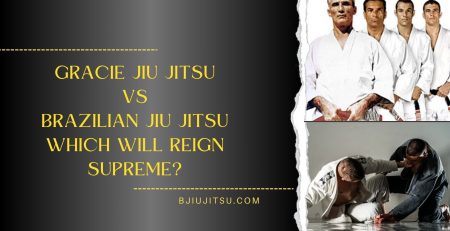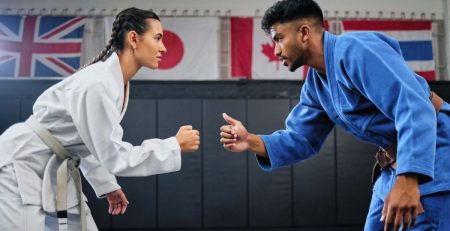Brazilian Jiu Jitsu VS Wrestling – Which Grappling Art Reigns Supreme?
Table of Contents:
- Introduction
- History and Origins
- Philosophies and Objectives
- Techniques and Training Methods
- Physical Demands and Fitness Benefits
- Application in Combat Sports
- Self-Defense and Real-Life Scenarios
- Mental Discipline and Strategic Thinking
- Community and Culture
- Conclusion
1. Introduction:
Brazilian Jiu-Jitsu (BJJ) and wrestling are two prominent grappling arts that have captivated martial artists and enthusiasts worldwide. While both disciplines involve close-quarters combat and ground fighting, they have distinct histories, philosophies, and techniques. This comprehensive comparison aims to delve into the intricacies of BJJ and wrestling, shedding light on their similarities, differences, and respective benefits.
2. History and Origins:
BJJ traces its roots back to Japan, where Judo was developed by Jigoro Kano in the late 19th century. Mitsuyo Maeda, a student of Kano, brought Judo to Brazil, where it was further refined and adapted by the Gracie family into what is now known as Brazilian Jiu-Jitsu. On the other hand, wrestling boasts a rich history that spans centuries, with evidence of grappling contests dating back to ancient civilizations like Mesopotamia and Egypt. Modern wrestling, particularly Greco-Roman and Freestyle, gained prominence in the Olympic Games and collegiate circuits.
3. Philosophies and Objectives:
The philosophies of BJJ and wrestling reflect their distinct goals and approaches to combat. BJJ places a strong emphasis on leverage, technique, and strategy, allowing practitioners to overcome larger opponents through skillful manipulation and submission holds. In contrast, wrestling prioritizes explosiveness, athleticism, and dominance, aiming to control and pin opponents to the mat for victory. While both disciplines share the goal of achieving positional superiority, their methodologies vary significantly.
4. Techniques and Training Methods:
BJJ encompasses a wide range of techniques, including joint locks, chokes, sweeps, and submissions, with an emphasis on ground-based combat. Training typically involves drilling specific movements, positional sparring, and live rolling sessions to simulate real-world scenarios. Wrestlers, on the other hand, focus on takedowns, throws, and mat wrestling, honing their skills through repetitive drilling, live wrestling matches, and strength and conditioning exercises. The training methodologies of BJJ and wrestling reflect their respective competitive formats and strategic priorities.
5. Physical Demands and Fitness Benefits:
Both BJJ and wrestling demand a high level of physical fitness, but they emphasize different attributes. Wrestling emphasizes explosive strength, agility, and cardiovascular endurance, as matches are fast-paced and physically demanding. BJJ places more emphasis on muscular endurance, flexibility, and technique, allowing practitioners to conserve energy and outmaneuver opponents. Engaging in either discipline can lead to improvements in overall fitness, including strength, endurance, and body composition.
6. Application in Combat Sports:
BJJ and wrestling have become integral components of mixed martial arts (MMA), with many MMA fighters incorporating techniques from both disciplines into their arsenals. Wrestlers leverage their takedown skills and positional dominance, while BJJ practitioners capitalize on their ground fighting and submission expertise. The synergy between BJJ and wrestling has led to a more well-rounded approach to MMA, with fighters blending grappling techniques seamlessly with striking and clinch work.
7. Self-Defense and Real-Life Scenarios:
Both BJJ and wrestling offer practical self-defense skills that can be invaluable in real-life situations. BJJ’s focus on controlling and neutralizing opponents, coupled with its emphasis on submissions and escapes, provides effective tools for self-protection. Wrestling’s emphasis on takedowns and ground control also translates well to self-defense scenarios, enabling practitioners to immobilize and subdue attackers. By training in either discipline, individuals can develop confidence, situational awareness, and the ability to defend themselves effectively. If you’re eager to delve deeper into Brazilian Jiu Jitsu’s applications for self-defense, be sure to explore our comprehensive article on the topic: “Brazilian jiu jitsu self defense.” Discover practical techniques and strategies tailored to real-life situations, empowering you with invaluable skills for personal safety and confidence in challenging scenarios.
8. Mental Discipline and Strategic Thinking:
BJJ and wrestling require mental discipline, adaptability, and strategic thinking, as practitioners must anticipate and react to their opponent’s movements. In BJJ, practitioners must remain calm under pressure, analyze their opponent’s vulnerabilities, and execute techniques with precision. Wrestlers must similarly strategize their attacks, anticipate counters, and exploit openings while maintaining relentless pressure. Both disciplines foster mental fortitude, problem-solving skills, and the ability to perform under duress.
9. Community and Culture:
The BJJ and wrestling communities offer unique camaraderie, support networks, and cultural traditions that enrich the practitioner’s experience. BJJ academies cultivate a sense of camaraderie, mutual respect, and inclusivity, with practitioners often forming lifelong friendships on the mats. Wrestling programs foster teamwork, discipline, and camaraderie, with athletes forging bonds through shared challenges and triumphs. Whether in the gym or on the mat, both BJJ and wrestling provide opportunities for personal growth, mentorship, and belonging.
For further information about “Brazilian Jiu-Jitsu vs. Bodybuilder,” you can check out this article Brazilian Jiu Jitsu vs Bodybuilder.
For further information about “Brazilian Jiu-Jitsu vs. MMA” guide, you can check out this article Brazilian Jiu Jitsu vs MMA.
For further information about “Brazilian Jiu-Jitsu vs. Kickboxing,” you can check out this article Brazilian Jiu Jitsu vs Kickboxing.
10. Conclusion:
In conclusion, Brazilian Jiu-Jitsu and wrestling are two distinct yet complementary grappling arts that offer unique benefits to practitioners of all skill levels. While BJJ excels in ground-based combat, submissions, and strategic positioning, wrestling shines in takedowns, explosive athleticism, and mat control. Whether you’re drawn to the technical finesse of BJJ or the raw power of wrestling, both disciplines provide avenues for personal growth, physical fitness, and self-defense proficiency.
In the realm of combat sports, BJJ and wrestling have become essential components of training for aspiring fighters and seasoned professionals alike. MMA fighters often cross-train in both disciplines to develop a well-rounded skill set that encompasses striking, grappling, and defensive tactics. Wrestlers leverage their takedown prowess to dictate the pace of a fight, while BJJ practitioners capitalize on their ground fighting expertise to secure submissions and control opponents. The integration of BJJ and wrestling techniques has revolutionized MMA, leading to more dynamic and versatile fighters in the cage.
Beyond the confines of the gym or the octagon, BJJ and wrestling offer practical self-defense skills that can empower individuals in real-life scenarios. Whether facing a physical altercation or navigating challenging situations, the principles of leverage, control, and technique learned in BJJ and wrestling can be invaluable. By instilling confidence, situational awareness, and the ability to remain calm under pressure, both disciplines equip practitioners with the tools to protect themselves and others when it matters most.
In addition to physical prowess, BJJ and wrestling foster mental discipline, resilience, and strategic thinking. Practitioners learn to adapt to changing circumstances, anticipate their opponent’s movements, and execute techniques with precision. Whether executing a complex submission chain in BJJ or orchestrating a series of takedowns in wrestling, the mental fortitude cultivated on the mats translates to other areas of life, including academics, career, and personal relationships.
Furthermore, the BJJ and wrestling communities provide a supportive and inclusive environment where practitioners of all backgrounds can thrive. Whether training in a BJJ academy or wrestling club, individuals benefit from mentorship, camaraderie, and shared goals. The bonds forged through sweat, perseverance, and mutual respect extend beyond the mats, creating lifelong friendships and a sense of belonging. In a world that often feels divided, BJJ and wrestling serve as unifying forces that bring people together through a shared passion for grappling and personal development.
In conclusion, the debate between Brazilian Jiu-Jitsu and wrestling ultimately boils down to personal preference, goals, and individual strengths. Whether you’re drawn to the technical intricacies of BJJ or the physicality of wrestling, both disciplines offer a pathway to self-improvement, athletic excellence, and a deeper understanding of the martial arts. By embracing the principles of discipline, perseverance, and humility, practitioners of BJJ and wrestling embark on a transformative journey that extends far beyond the confines of the gym or the competition mat.
Certainly! Here are some frequently asked questions (FAQs) related to the comparison between Brazilian Jiu-Jitsu (BJJ) and wrestling:
Q1. What are the main differences between Brazilian Jiu-Jitsu and wrestling?
A: Brazilian Jiu-Jitsu (BJJ) is primarily focused on ground-based combat, emphasizing submissions and strategic positioning, while wrestling focuses on takedowns, explosive athleticism, and controlling opponents on the mat. BJJ incorporates a wider variety of submissions and techniques, whereas wrestling typically involves a narrower range of moves focused on takedowns and pinning.
Q2. Which discipline is better for self-defense: BJJ or wrestling?
A: Both BJJ and wrestling offer valuable self-defense skills, but they approach combat from different angles. BJJ excels in controlling opponents on the ground and utilizing submissions to neutralize threats, making it highly effective in real-life altercations. On the other hand, wrestling emphasizes takedowns and mat control, which can be advantageous in situations where standing dominance is crucial.
Q3. Can I practice both Brazilian Jiu-Jitsu and wrestling simultaneously?
A: Yes, many athletes choose to cross-train in both BJJ and wrestling to develop a well-rounded skill set. Combining elements of each discipline can enhance your overall grappling proficiency and adaptability, whether you’re training for competitive sports like MMA or seeking to improve your self-defense capabilities.
Q4. Which discipline is more physically demanding: BJJ or wrestling?
A: Both BJJ and wrestling require significant physical exertion and conditioning. Wrestling is often characterized by explosive movements, endurance, and strength, whereas BJJ relies more on technique, leverage, and positional awareness. The physical demands of each discipline may vary based on individual preferences and training intensity.
Q5. Are BJJ and wrestling suitable for beginners?
A: Yes, both BJJ and wrestling accommodate practitioners of all skill levels, including beginners. Many gyms and clubs offer introductory classes specifically designed for newcomers, providing a supportive environment to learn fundamental techniques, drills, and concepts. Whether you’re interested in grappling as a hobby, sport, or self-defense, there are resources available to help you get started.
Q6. Do I need any special equipment to practice BJJ or wrestling?
A: The equipment requirements for BJJ and wrestling differ slightly. In BJJ, practitioners typically wear a gi (uniform), consisting of a jacket, pants, and belt, which facilitates grips and submissions. No-gi BJJ utilizes rashguards and shorts instead of the gi. In wrestling, athletes wear a singlet (tight-fitting uniform) and wrestling shoes for traction on the mat. Mouthguards may also be recommended for both disciplines, especially during sparring or competition.
Q7. How can I choose between BJJ and wrestling if I’m undecided?
A: Ultimately, the choice between BJJ and wrestling depends on your personal interests, goals, and preferences. Consider factors such as your affinity for ground-based combat versus stand-up grappling, your physical attributes and strengths, and whether you’re primarily interested in sport, self-defense, or fitness. Experimenting with introductory classes or consultations with coaches can also help you make an informed decision based on your individual needs and aspirations.














Leave a Reply
You must be logged in to post a comment.